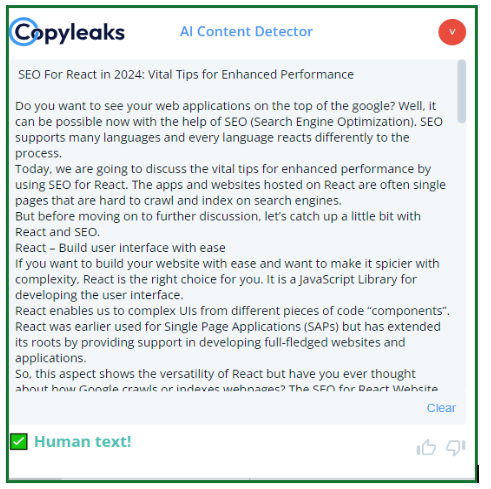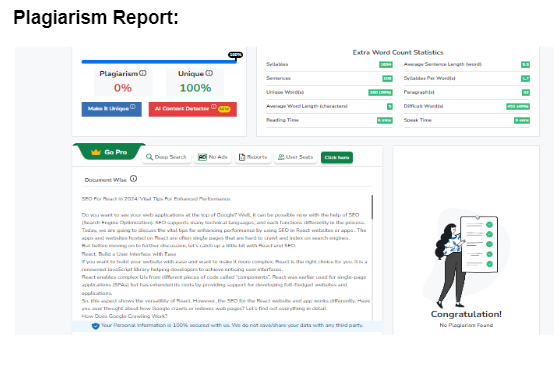SEO for React requires server-side rendering (SSR) or pre-rendering to ensure search engine visibility. Use tools like Next.js for SSR, provide proper metadata, use descriptive URLs, and optimize content loading. Managing SEO in React involves addressing client-side rendering challenges to ensure search engines can crawl, and index content effectively.
Do you want to see your web applications at the top of Google? With the help of SEO (search engine optimization), it can be possible now. SEO supports many technical languages, and each functions differently in the process.
Today, we will discuss vital tips for enhancing performance using SEO on React websites or apps. The apps and websites hosted on React are often single pages that are hard to crawl and index on search engines.
But before moving on to further discussion, let’s catch up briefly with React and SEO.
React: Build a User Interface with Ease
If you want to build your website easily and make it more complex, React is the right choice for you. It is a renowned JavaScript library that helps developers achieve enticing user interfaces.
React enables complex UIs from different pieces of code called “components.”. React was earlier used for single-page applications (SPAs) but has extended its roots by providing support for developing full-fledged websites and applications.
So, this aspect shows the versatility of React. However, the SEO for the React website and app works differently. Have you ever thought about how Google crawls or indexes web pages? Let’s find out everything in detail.
How Does Google Crawling Work?
To reach your website’s users, you need to focus on the basic SEO terms, and a professional will aid you in every context.
Here is the process of how Google works to understand it in more detail:
- Googlebot saves the contents of server responses it receives via GET requests for the URLs in the crawl queue. Googlebot does this for image files, JS, CSS, HTML, and more.
- This involves appending URLs to the crawl queue that are contained in HTML <a href> links. Queuing resource URLs (CSS/JS) from <link> tags and images from <img src> tags are also included. Googlebot will not render the content, and Caffeine, Google’s indexer, will not index it if it discovers a no-index tag at this point in the process.
- Googlebot looks for more content in the DOM but not in the HTML source by running JavaScript code in a headless Chrome browser. This is carried out for all HTML URLs.
- After normalizing the data and fixing any broken HTML, caffeine attempts to make sense of the data from Googlebot and precomputes some ranking signals that will be displayed in a search engine result.
So, this is the process by which Google’s crawl of indexes works. But you need to know the SEO issues that appear with React. Our next approach is discovering the common SEO issues and challenges for React websites and apps.
Common SEO Issues for React JS Websites and Apps
You might face these challenges if you are doing website development through React. SEO for React can be tricky as you need to understand the virtual DOM, client-side rendering, and many more things. From single-page applications to complete website development, React has come a long way.
However, SEO for React JS is complex, and you need to know the common challenges that arise while doing search engine optimization:
- Page loading
- Metadata handling
- Performance optimization
- Content loading
- URL structure
- Mobile responsiveness
- Sitemap and Robots.txt
- Content duplication
These are some of the most common issues a developer faces while doing SEO for React apps. You need to work on each one to optimize the website’s performance.
Let’s find out some vital tips for enhancing SEO performance in 2024.
Core Vital Tips for SEO for React
Doing SEO for React JS in 2024 will be easy for you. Well, here are some crucial tips to solve all your issues. We have curated and discovered some tips and tricks for enhanced performance.
Let’s catch up on some in detail.
Initial Page Loading
It is important to deploy the server-side rendering with the help of Next.js or Gatsby to generate SEO-friendly HTML. It would help the search engine crawl and index the website content effectively.
Metadata Management
A website should have an optimized title, description, and canonical tags for smooth SEO. You can use react-helmet for this, as it helps manage the meta tags per page.
Check the URL Structure
Making clean and descriptive URLs is important for the React app. An SEO expert should use React Router for routing and ignore the hash fragments.
Accessible to All
SEO-friendly websites and apps ensure accessibility standards like semantic HTML, adding ALT text for images, and keyboard navigation for disabled users. Thus, check these aspects of SEO for React apps and websites.
Eliminate Barriers to Optimization
Your website should be responsive and be able to be processed in microseconds. React Performance Optimization techniques suggest reducing unnecessary rendering, using code-splitting techniques, and optimizing images for enhanced SEO performance.
Content Loading
The content should be loaded quickly. It is possible by adding and placing the placeholder; it ensures a great user experience, and content gets fetched effectively.
XML Sitemap Updation
A sitemap is helpful in SEO because it enables the search engine to index the page. So, with the help of the robots.txt file, your website will start crawling.
Content Delivery Network (CDN) is Equally Important
A content delivery network, or CDN, is a global network of servers that enables users to access the content of your website. Your website’s loading speed can be increased by using a CDN, which will help your SEO.
Mobile Responsiveness
Make your application and website mobile-responsive by reading the Google Standards. More than 50% of users are searching websites on their mobile devices. Thus, you need to focus and wisely take the required actions.
Backlinks are the Backbone
Backlinks are effective connections made to your website by other websites. By monitoring the backlink profile, search engines can tell that your website is reliable and authoritative. It fulfills the Google guideline “EAT” and enables the website to crawl and rank higher in the Google search engine result pages.
Analytics and Monitoring
Enable Google Analytics 4 on your website to monitor its SEO performance. Inspect and address the Google search console for crawling errors and other challenges. It would help make your website more responsive.
Avoid Content Duplication
Start using canonical tags to present the preferred page version. It helps prevent content duplication issues. Ensure that your SPAs handle the content rendering to avoid duplication of content.
Ending Note
These tips and tricks will make SEO for React websites and apps easy. You can win the game by working on common SEO issues and challenges.
Also, it would help if you were patient sometimes because SEO is time-consuming and takes some time to crawl on SERP. Moreover, one more thing to remember while doing SEO for React websites or apps is monitoring and checking backlinks.
So, do your SEO wisely and stay with the tips for the most outstanding results.
REPORTS:-
AI Detection Report:



